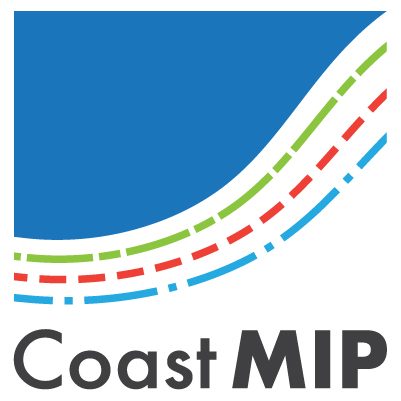Coastal impact model Inter-comparison Project
CoastMIP is an open, community-driven initiative aimed at comparing, generating and synthesising policy-relevant information on coastal impacts of climate change and sea-level rise at global and continental scales (called large-scales hereafter). Such assessments are needed for informing a range of policy decisions including: i) setting global mitigation targets in the context of the UNFCCC to avoid “dangerous interference with the climate system”; ii) designing global financial mechanisms for adaptation and loss & damage, and iii) strategic long-term adaptation planing.
In order to be salient for policy making, such impact assessments must systematically consider all major uncertainties including scenario uncertainty, climate model uncertainty, internal variability and impact model uncertainty. A failure to do so can misguide decisions. The former three types of uncertainties have been explored substantially, but uncertainties in climate impact models have only recently received attention through systematic impact model inter-comparisons either within sectors (e.g. AgMIP for the agricultural sector, FISH-MIP for the fishery sector) or as part of the Inter-Sectoral Inter Comparisons Project (ISI-MIP).
So far coastal climate change impacts assessments have not been organized within model inter comparisons that allow to quantify uncertainties coming from different methods, data and models applied, mainly because few continental and global scale studies and models have been available. In recent years, data and methods for assessing large scale coastal flood risk assessments have developed rapidly (Abadie et al., 2016; Diaz, 2016; Hallegatte et al., 2013; Hinkel et al., 2014; Vousdoukas et al., 2016) and large-scale storm surge and wind-wave models as well as high frequency sea level observations are increasingly becoming available (Muis et al., 2016; Vousdoukas et al., 2017; Cid et al., 2017; Wang et al., 2014; CAWCR data set; Mentaschi et al., 2017).
The goal of CoastMIP is to build on those recent developments and to set up a process that brings together the coastal impact modelling community to assess all major dimensions of impact assessment uncertainties across models, as a contribution to the cross-sectoral ISIMIP project. ISIMIP offers a consistent framework for climate impact simulations across different sectors and scales and makes them freely available for the research community and the wider public similar to the CMIP simulations of climate change (www.isimip.org).
The first focus of the comparison will lie on the current and future sea-level rise induced coastal flood risk, as this is expected to be one of the major impacts of climate change. Following the risk framework of IPCC AR5, flood risk is understood as a combination of hazard, exposure and vulnerability (Oppenheimer et al., 2014; Wong et al., 2014). Uncertainty analysis and model-inter-comparisons will be conducted for two separate parts of the flood risk modelling cascade:
- Assessments of current and future coastal flood hazard, defined here as the coastal extreme sea level (ESL) including tides, surge and wave set-up.
- Assessments of coastal flood impacts using the input of the hazard inter-comparison (1.) with different inundation and damage models (called impact models hereafter) for assessing coastal flood impacts such as flood extent, people affected and economic losses.
As a first step, CoastMIP will draft a review paper on the main uncertainty dimensions of coastal flood risk assessment, including uncertainties in data, simulation models, statistical models and other methods involved in the cascade of methods applied to quantify current and future flood risk under climate change. This wider interpretation of impact model is necessary, because some of the major uncertainties in projecting future flood risk stem from, e.g., the data models (Hinkel et al., 2014) or extreme value analysis methods (Wahl et al., 2017) employed. Based on this, we will develop a protocol that conforms with the cross-sectoral ISIMIP protocol and specifies the exact impact model simulations and comparisons to be performed. Finally, results will be analysed, made publicly available on the ISIMIP website and published in a peer-reviewed journal.
CoastMIP does not provide any funding for the envisaged activities, but relies on voluntary contributions. The goal thus is to create synergies between funded projects and other existing activities that can contribute to the overall agenda of CoastMIP.
